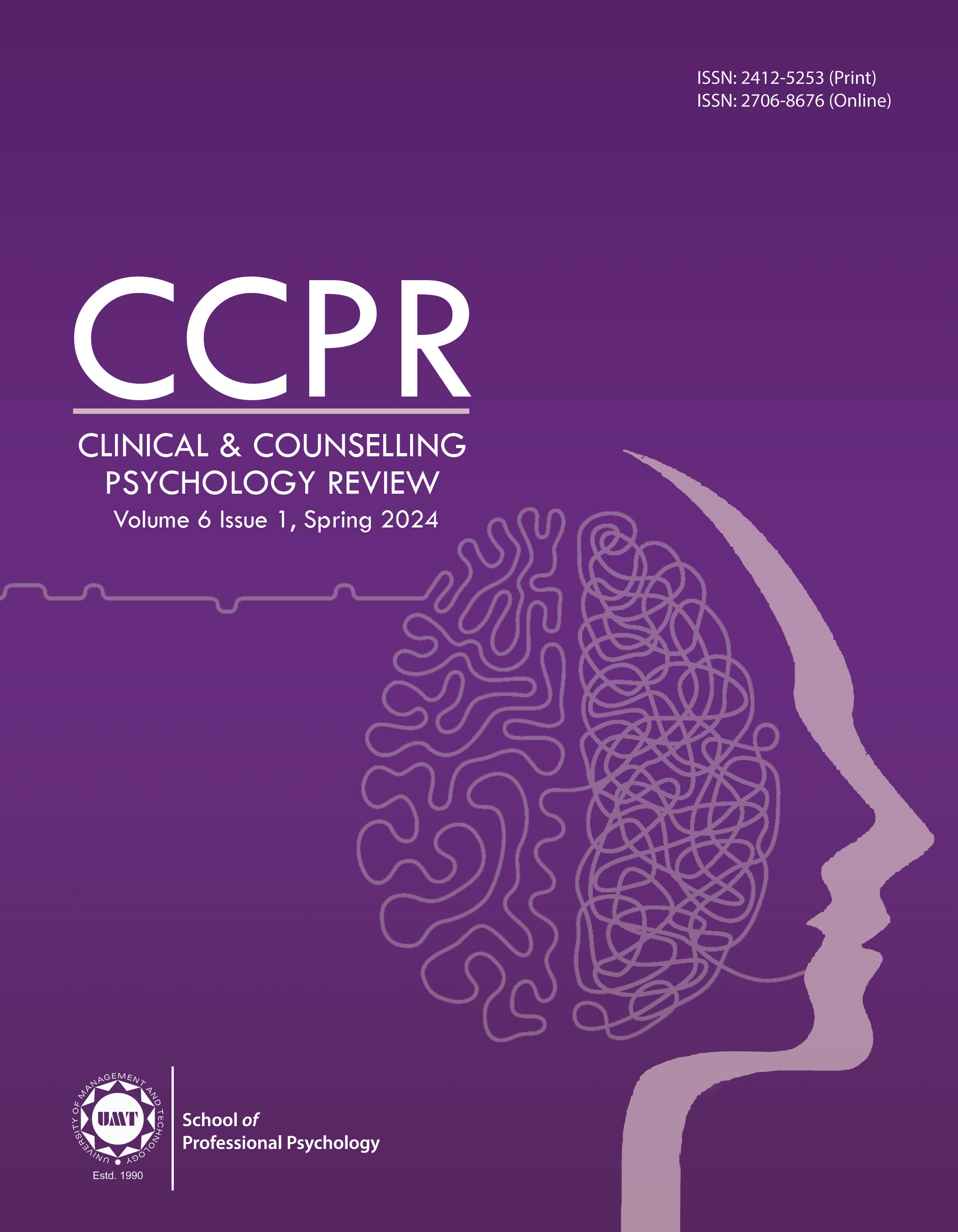Disparities of Depression and Anxiety among Medical Students
Abstract
 Abstract Views: 0
Abstract Views: 0
The current study sought to assess the gender differences in relation to anxiety and depression among medical students. This cross-sectional study took a sample consisted (N=240) of medical students (males: n=104 and females: n=136) with a mean age of 22.9 years (SD=2.13). For assessment, Beck Depression Inventory (BDI) and Beck Anxiety Inventory (BAI) were used. Data was stored and analyzed in SPSS version 2.1. Findings demonstrated that 32.4% students scored at the minimal range of depression, while 30.3% scored at mild depression level, 23.4% were at moderate level of depression, and 13.9% students scored at severe depression level. Approximately, 27.4% students scored at minimal range of anxiety, students with mild anxiety were 33.6%, and 20.3% students were at moderate anxiety level, while 18.7% students scored at severe level of anxiety. By applying independent sample t-test to determine gender differences, results demonstrated no significant gender differences in depression (p> .05). However, a significant difference was found for anxiety where male students exhibited higher levels of anxiety than females (p< .05). Moreover, depression and anxiety were significantly higher among hostelite students than day-scholars (p<.05). It was concluded that a marked number of medical students had clinically significant symptoms of depression and anxiety. The frequency was higher among hostelite students than day-scholars, and male students experienced more anxiety than female students. The study findings highlighted gender and residential presentation of the students as a risk factor of depression and anxiety among the medical students.
Downloads
References
Ali, A., Rao, M. H., Ali, S., Ahmed, T., Safi, M., Malik, A., & Husan, B. (2014). Prevalence of anxiety and depression and their associated risk factors among engineering students in Karachi, Pakistan. International Journal of Emerging Technology and Advanced Engineering, 4(9), 52–55.
American Psychiatric Association. (2013). Diagnostic and statistical manual of mental disorders(DSM-5-TR). https://www.psychiatry.org/psychiatrists/practice/dsm
Beck, A. T., Epstein, N., Brown, G., & Steer, R. A. (1988). An inventory for measuring clinical anxiety: Psychometric properties. Journal of Consulting and Clinical Psychology, 56(6), 893–897. https://doi.org/10.1037/0022-006X.56.6.893
Beck, A. T., Steer, R. A., & Carbin, M. G. (1988). Psychometric properties of the Beck Depression Inventory: Twenty-five years of evaluation. Clinical Psychology Review, 8(1), 77–100. https://doi.org/10.1016/0272-7358(88)90050-5
Bellos, S., Skapinakis, P., Rai, D., Zitko, P., Araya, R., Lewis, G., Lionis, C., & Mavreas, V. (2013). Cross-cultural patterns of the association between varying levels of alcohol consumption and the common mental disorders of depression and anxiety: Secondary analysis of the WHO Collaborative Study on Psychological Problems in General Health Care. Drug And Alcohol Dependence, 133(3), 825–831. https://doi.org/10.1016/j.drugalcdep.2013.08.030
Bennett, D., McCarty, C., & Carter, S. (2021). Grit, financial stress, and academic success for FGCS. Journal of Instructional Pedagogies, 26, 1–26.
Chatmon, B. N. (2020). Males and mental health stigma. American Journal of Men's Health, 14(4), 1–3. https://doi.org/10.1177/1557988320949322
Dyrbye, L. N., Thomas, M. R., & Shanafelt, T. D. (2006). Systematic review of depression, anxiety, and other indicators of psychological distress among US and Canadian medical students. Academic Medicine, 81(4), 354–373.
Ebesutani, C., Fierstein, M., Viana, A. G., Trent, L., Young, J., & Sprung, M. (2015). The role of loneliness in the relationship between anxiety and depression in clinical and school‐based youth. Psychology in the Schools, 52(3), 223–234. https://doi.org/10.1002/pits.21818
Eisler, R. M., Skidmore, J. R., & Ward, C. H. (2019). Masculine gender-role stress: Predictor of anger, anxiety, and health-risk behaviors. Journal of Personality Assessment, 52(1), 133–141. https://doi.org/10.1207/s15327752jpa5201_12
Ferrari, A. J., Charlson, F. J., Norman, R. E., Patten, S. B., Freedman, G., Murray, C. J., Vos, T., & Whiteford, H. A. (2013). Burden of depressive disorders by country, sex, age, and year: Findings from the global burden of disease study 2010. PLoS Medicine, 10(11), Article e1001547. https://doi.org/10.1371/journal.pmed.1001547
Gul, N., Ali, A., Rizwanullah, Khayam, Khan, M. S., Gul, F., Gul, A., Shehriyar, Ali, K., & Haseeb, S. O. (2024). Prioritizing mental health: A cross-sectional investigation of depression prevalence and risk factors among medical students in Peshawar, Pakistan. International Journal of Medical Students, 12(1), 22–28. https://doi.org/10.5195/ijms.2024.2173
Hashmi, A. M., Aftab, M. A., Naqvi, S. H., Sajjad, W., Mohsin, M., & Khawaja, I. S. (2014). Anxiety and depression in Pakistani medical students: A multicenter study. Health Med, 8(7), 813–820.
Hossain, M. K., Mahfuz, T., Latif, S., & Hossain, M. E. (2023). Determinants of financial stress among university students and its impact on their performance. Journal of Applied Research in Higher Education, 15(1), 226–237. https://doi.org/10.1108/JARHE-02-2021-0082
Houkes, I., Winants, Y., Twellaar, M., &Verdonk, P. (2011). Development of burnout over time and the causal order of the three dimensions of burnout among male and female GPs. A three-wave panel study. BMC Public Health, 11, Article e240. https://doi.org/10.1186/1471-2458-11-240
Hu, K. S., Chibnall, J. T., &Slavin, S. J. (2019). Maladaptive perfectionism, impostorism, and cognitive distortions: Threats to the mental health of pre-clinical medical students. Academic Psychiatry, 43, 381–385. https://doi.org/10.1007/s40596-019-01031-z
Ihsan, A. H., Khan, M. M., Ullah, M., Khan, Q. A., & Khan, S. U. (2025). Prevalence and risk factors of depression among university students in Peshawar. Indus Journal of Bioscience Research, 3(1), 827–834. https://doi.org/10.70749/ijbr.v3i1.599
Jamali, Y. A., Khan, J. A., Jamali, I. A., Shah, H., & Kumari, R. (2024). Depression, anxiety and stress among undergraduate students of Shah Abdul Latif University, Khairpur: Depression, anxiety and stress among students. Pakistan Journal of Health Sciences, 5(4), 99–104. https://doi.org/10.54393/pjhs.v5i04.1384
Khan, D. A., Khan, M. T., Masih, A. G., Siddiqui, D. A., Parvez, A., Ali, F. M., & Bibi, A. (2024). Anxiety, depressive symptoms and socio-demographic factors associated with self-esteem among male nursing students: Self-Esteem among male nursing students. Pakistan Journal of Health Sciences, 5(1), 15–20. https://doi.org/10.54393/pjhs.v5i01.1249
Khan, M. S., Mahmood, S., Badshah, A., Ali, S. U., & Jamal, Y. (2006). Prevalence of depression, anxiety and their associated factors among medical students in Karachi, Pakistan. Journal-Pakistan Medical Association, 56(12), 583–586.
Mansoor, U. L., & Ali, M. A. M. H. (2015, December 7–8). Impact of hostel students’ satisfaction on their academic performance in Sri Lankan universities [Paper presentation]. 5th International Symposium, Oluvil, Sri Lanka. http://ir.lib.seu.ac.lk/handle/123456789/1318
Minchekar, V. S., & Mangore, N. D. (2019). Home emotional and social adjustment and mental health among hostel students. Think India Journal, 22(38), 31–36.
Moeller, R. W., & Seehuus, M. (2019). Loneliness as a mediator for college students' social skills and experiences of depression and anxiety. Journal of Adolescence, 73, 1–13. https://doi.org/10.1016/j.adolescence.2019.03.006
Moradi, G. (2008). Correlation between social capital and mental health among hostel students of Tehran and shiraz universities. Social Welfare Quarterly, 8(30), 143–170.
Mosley, T. H. Jr., Perrin, S. G., Neral, S. M., Dubbert, P. M., Grothues, C. A., & Pinto, B. M. (2019). Stress, coping, and well-being among third-year medical students. Academic Medicine, 69(9), 765–777.
Pacheco, J. P., Giacomin, H. T., Tam, W. W., Ribeiro, T. B., Arab, C., Bezerra, I. M., & Pinasco, G. C. (2017). Mental health problems among medical students in Brazil: A systematic review and meta-analysis. Brazilian Journal of Psychiatry, 39, 369–378. https://doi.org/10.1590/1516-4446-2017-2223
Rab, F., Mamdou, R., & Nasir, S. (2008). Rates of depression and anxiety among female medical students in Pakistan. EMHJ-Eastern Mediterranean Health Journal, 14(1), 126–133.
Rizvi, F., Qureshi, A., Rajput, A. M., & Afzal, M. (2015). Prevalence of depression, anxiety and stress (by DASS scoring system) among medical students in Islamabad, Pakistan. British Journal of Medicine and Medical Research, 8(1), 69–75.
Rotenstein, L. S., Ramos, M. A., Torre, M., Segal, J. B., Peluso, M. J., Guille, C., Sen, S., & Mata, D. A. (2016). Prevalence of depression, depressive symptoms, and suicidal ideation among medical students: A systematic review and meta-analysis. JAMA, 316(21), 2214–2236. https://doi.org/10.1001/jama.2016.17324








